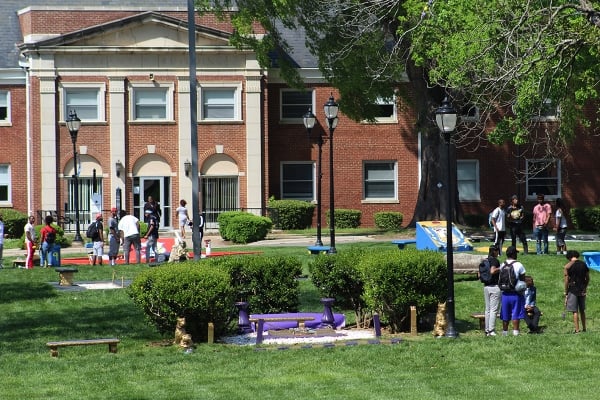As the stated deadline to sign the “Compact for Academic Excellence in Higher Education” arrived Friday, multiple universities have already rejected the deal while only a few institutions have expressed interest.
But among the public universities that were either formally invited to sign the compact or that participated in a call with the White House to provide feedback on higher education issues, none are willing to discuss their deliberations about the proposal or interactions with federal officials.
Last month, Inside Higher Ed sent public records requests to Arizona State University, the University of Arizona, the University of Kansas, the University of Texas at Austin and the University of Virginia, seeking emails, text messages, internal presentations and other documents related to how presidents, trustees and other officials discussed the compact.
As of Friday, none had provided those records. Only the University of Kansas indicated a willingness to do so, but it requested an up-front $100 fee for staff time to conduct the search. However, officials said they could not guarantee the requested records would be provided.
Texas, meanwhile, has appealed to the state attorney general to avoid releasing the requested records. Now uncertainty abounds about what UT Austin will do on the day of the initial deadline, though conservative media has reported the Trump administration could push that date back (which officials did not confirm Thursday) as it struggles to find signatories.
Texas
Some public universities, such as Arizona and Virginia, have rejected the compact outright, but others, like Arizona State, have noted they never received a formal invitation to join and therefore they have nothing to decline. But UT Austin has remained silent about whether it will sign the compact.
Although University of Texas system Board of Regents chairman Kevin P. Eltife issued an early statement saying that he welcomed the “the new opportunity presented to us and we look forward to working with the Trump Administration on it,” officials have said little since then.
In response to an Oct. 22 public records request from Inside Higher Ed, UT Austin shared only the initial emails exchanged by federal and university officials inviting the university to consider the compact, a copy of the proposal itself, and Eltife’s statement. The rest it wants to keep private.
UT system officials argued in a letter sent Tuesday to the attorney general’s office that the requested records are protected by attorney-client privilege and should not be disclosed.
“In the information at issue, University and UT System attorneys are providing legal counsel, gathering information in order to provide legal counsel, or their clients are seeking legal advice from the attorneys and include the necessary background information so that counsel will be able to render an opinion on a given situation,” UT system attorney Jennifer Burnett wrote in the letter. “From the text of the communications, it is evident that the University and UT System attorneys for were [sic] involved in providing legal counsel to employees of the University.”
Now the attorney general’s office has 10 business days to make a determination on the request.
Gunita Singh, a staff attorney for the Reporters Committee for Freedom of the Press, told Inside Higher Ed by email that the university “is within its rights to argue that the records are privileged but they need to make a particularized showing that that is the case,” proving the requested documents “pertain to the provision of legal advice” and have been confidential at all times.
Virginia
The University of Virginia has yet to provide documents requested Oct. 22 in what appears to be a pattern of delayed responses, according to others who sought records from the public university in recent months.
UVA’s student newspaper, The Cavalier Daily, reported that it has submitted 25 public records requests to the university, but UVA officials have reportedly not provided records since July 1. Other journalists across the commonwealth have taken to social media to note that they have struggled to get information on athletic staffing and internal communications.
State Senator Creigh Deeds, a Democrat who has represented the Charlottesville area for more than two decades, also struggled to get public records out of the university related to the resignation of former UVA president Jim Ryan, who stepped down in June under federal pressure. Deeds initially reached out to the university Aug. 1 seeking information, which he only obtained after submitting a public records request and paying $4,500 for the documents.
Chris Seaman, a law professor at Washington and Lee University, requested public records related to costs for outside legal counsel on July 2. But Seaman still has not “received a substantive response from UVA regarding my FOIA request,” he told Inside Higher Ed by email. In an August email exchange shared by Seaman, a UVA official noted a delay in processing his request and wrote that “in the last few weeks, our office has received an unusually large volume of requests with limited staff to process them.” They also promised to “expedite handling” of his request, but more than three months later, Seaman said, he is still awaiting those documents.
UVA spokesperson Brian Coy did not address the pattern of delays in a response to Inside Higher Ed, writing that the university “has received this request and is processing it in accordance with Virginia law” and is “preparing an estimate of anticipated costs” for review.
Arizona and Arizona State
Public records requests at Arizona State and the University of Arizona also remain unfulfilled after 30 days.
Arizona State spokesperson Jerry Gonzalez said that he would check on the state of the request but noted that ASU was not invited to sign the compact, and so “there is nothing for the university to accept, reject, or negotiate.” (However, President Michael Crow has said he’s had discussions with Education Secretary Linda McMahon and other officials about higher education issues.)
University of Arizona spokesperson Mitch Zak said that Inside Higher Ed’s public records request “remains in process” and “response time varies.” He noted that factors such as “the specificity of the request, the volume of requests received, and the time required to locate, review, and redact materials subject to disclosure” all shape public records response times.
Arizona law does not specify how long public entities have to hand over documents but instructs that they do so “promptly.” Singh, the RCFP attorney, pointed to past legal cases in which Arizona courts found that 24 business days “satisfied the promptness standard” but that “a delay of 49 days, or 34 working days, did not meet the promptness standard” outlined in state law.
Currently, she said, Arizona and Arizona State are “inching toward noncompliance territory.”










